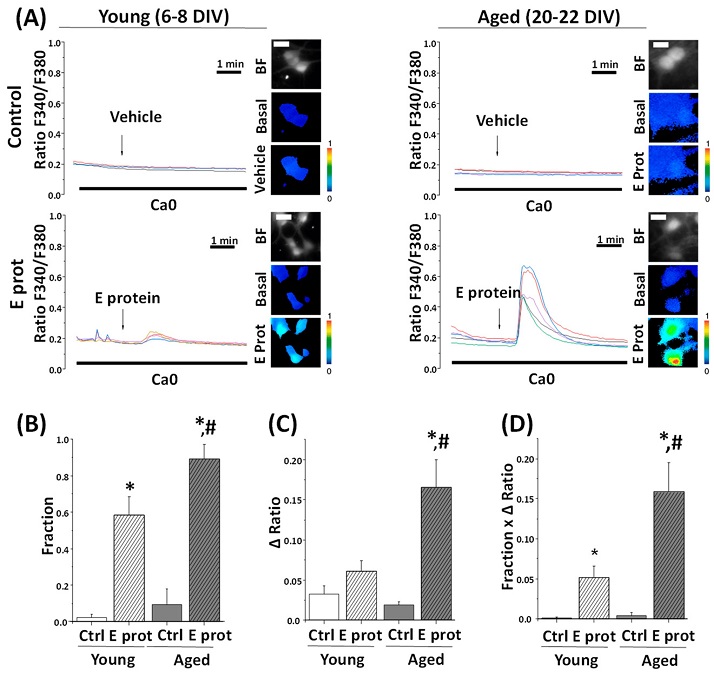Nikhil Prasad Fact checked by:Thailand Medical News Team Jun 07, 2024 1 year, 5 months, 1 week, 6 days, 23 hours, 29 minutes ago
COVID-19 News: The COVID-19 pandemic, caused by SARS-CoV-2, has led to widespread health issues, including significant neurological complications as seen in previous studies, cases reports and
COVID-19 News coverages. Recent research highlights the SARS-CoV-2 envelope protein (E protein) as a key player in these neurological effects. The E protein, a viroporin, forms ion channels in cell membranes essential for viral replication. However, its impact on neurons remained unclear until now.
 The SARS-CoV-2 E protein induces Ca2+ release from intracellular stores in young and aged hippocampal neurons. The release of Ca2+ store content was tested in hippocampal neurons from short-term (6–8 DIV) and long-term (20–22 DIV) cultures. Cells were loaded with fura2/AM (4 µM) and subjected to fluorescence Ca2+ imaging in external Ca2+-free medium. (A) The pictures show bright field (BF) and pseudocolor images of fluorescence ratios in basal conditions (Basal) and after vehicle (Vehicle) or E protein (E protein) treatment (2 μg/mL), in short-term (6–8 DIV) and long-term (20–22 DIV) cultured neurons. The bar represents 10 μm and applies to all photographs. Traces are representative recordings of fluorescence ratios in individual neurons identified by their morphology. (B) The bars correspond to the average (mean ± SEM) fraction of cells responding to vehicle or E protein, (C) maximum height ratio F340/F380 (Δ ratio) in responsive cells, (D) and the product of both parameters, n = 42, 63, 60 and 59 cells from 17 independent experiments. * p < 0.05 vs. control; # p < 0.05 vs. 6–8 DIV cultures. For (B–D) n = 42, 63, 60 and 59 cells from 17 independent experiments.
The Study
The SARS-CoV-2 E protein induces Ca2+ release from intracellular stores in young and aged hippocampal neurons. The release of Ca2+ store content was tested in hippocampal neurons from short-term (6–8 DIV) and long-term (20–22 DIV) cultures. Cells were loaded with fura2/AM (4 µM) and subjected to fluorescence Ca2+ imaging in external Ca2+-free medium. (A) The pictures show bright field (BF) and pseudocolor images of fluorescence ratios in basal conditions (Basal) and after vehicle (Vehicle) or E protein (E protein) treatment (2 μg/mL), in short-term (6–8 DIV) and long-term (20–22 DIV) cultured neurons. The bar represents 10 μm and applies to all photographs. Traces are representative recordings of fluorescence ratios in individual neurons identified by their morphology. (B) The bars correspond to the average (mean ± SEM) fraction of cells responding to vehicle or E protein, (C) maximum height ratio F340/F380 (Δ ratio) in responsive cells, (D) and the product of both parameters, n = 42, 63, 60 and 59 cells from 17 independent experiments. * p < 0.05 vs. control; # p < 0.05 vs. 6–8 DIV cultures. For (B–D) n = 42, 63, 60 and 59 cells from 17 independent experiments.
The Study
Researchers from the University of Valladolid and the Spanish National Research Council (CSIC) have delved into the effects of the SARS-CoV-2 E protein on neurons. Using rat hippocampal neuron cultures, they discovered that the E protein induces calcium (Ca2+) release from intracellular stores, leading to neuron apoptosis, particularly in aged neurons.
Key Findings
-E Protein Localization: The study showed that the E protein quickly enters hippocampal neurons and colocalizes with the endoplasmic reticulum (ER), an essential intracellular structure. This behavior was observed in both young (6-8 days in vitro, DIV) and aged (20-22 DIV) neuron cultures, indicating a consistent pattern of localization.
-Neuron Cell Death: A significant finding was that the E protein induced apoptosis in aged neurons but not in young ones. This suggests that aged neurons are more susceptible to the harmful effects of the E protein, likely due to age-related changes in cellular structures and functions.
-Calcium Dynamics: The E protein's impact on Ca2+ dynamics wa
s profound. It caused variable increases in cytosolic Ca2+ concentration, primarily through Ca2+ release from the ER. This release was significantly larger in aged neurons, correlating with their enhanced Ca2+ store content.
Mechanisms of Neuron Damage
The study provides insights into how the E protein's viroporin activity disrupts intracellular Ca2+ homeostasis, leading to neuron cell death. By forming ion channels in the ER membrane, the E protein depletes Ca2+ stores, triggering apoptosis. This process is exacerbated in aged neurons due to their larger Ca2+ stores and enhanced ER-mitochondria contacts, which are crucial for maintaining cellular functions.
Implications for Neurological Complications in COVID-19
These findings offer a possible explanation for the neurological symptoms observed in COVID-19 patients, especially older individuals. The E protein's ability to disrupt Ca2+ homeostasis and induce neuron cell death could contribute to the cognitive and neurological impairments reported in many COVID-19 cases.
Future Directions
Further research is needed to explore therapeutic strategies that can counteract the harmful effects of the E protein on neurons. Targeting the E protein's viroporin activity or enhancing the resilience of neuronal Ca2+ homeostasis could be potential approaches to prevent or reduce neurological damage in COVID-19 patients
Conclusion
The SARS-CoV-2 E protein plays a critical role in neuron cell death by disrupting Ca2+ homeostasis. This effect is more pronounced in aged neurons, providing a potential link between COVID-19 and age-related neurological complications. Understanding these mechanisms opens new avenues for mitigating the neurological impacts of COVID-19, particularly in vulnerable populations.
The study findings were published in the peer reviewed International Journal of Molecular Sciences.
https://www.mdpi.com/1422-0067/25/12/6304
For the latest
COVID-19 News, keep on logging to Thailand Medical News.
Read Also:
https://www.thailandmedical.news/news/sars-cov-2-e-protein-induces-long-term-immune-dysfunction
https://www.thailandmedical.news/news/scientists-discover-an-amyloidogenic-fragment-in-sars-cov-2-envelope-protein-that-promotes-serum-amyloid-a-misfolding-and-fibrillization
https://www.thailandmedical.news/news/unraveling-the-intricacies-of-sars-cov-2-evolution-the-role-of-envelope-protein-mutation-t9i-in-autophagy-resistance
